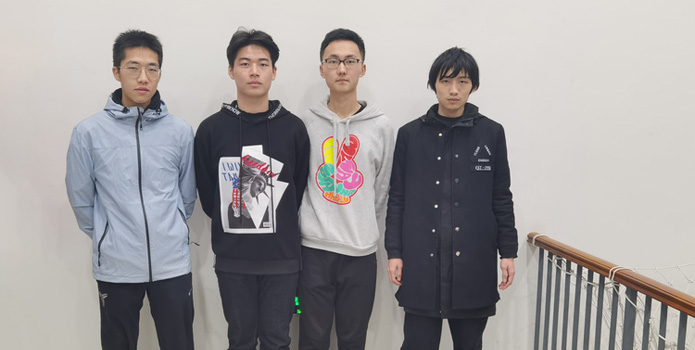
Student Projects
VG100

Indoor Positioning Car
Instructors: Dr. Mian Li, Dr. Irene Wei
Team Members: Zhengyang Han, Xinkai Wang, Haojun Xu, Houwu Liu
Project Video
Team Members

Team Members:
Zhengyang Han, Xinkai Wang, Haojun Xu, Houwu Liu
Instructors:
Dr. Mian Li, Dr. Irene Wei
Project Description
Problem
The existing indoor positioning technology based on Bluetooth or Wi-Fi has the characteristics of low precision and large delay. For indoor positioning scenarios with high accuracy requirements, such as floor robot positioning, the two can not satisfy.
Concept Generation
Our project aims to establish an indoor positioning system so as to achieve indoor high-precision positioning and provide technical support for the positioning system of the sweeping robot and so on. The positioning accuracy should exceed centimeter level and the latency should be less than 10 kps.
Design Description
Indoor positioning car based on ultrasonic ranging and three-point positioning principle is our final solution. The car is equipped with an omni-directional ultrasonic transmitter and Wi-Fi transceiver module. Three indoor base stations are equipped with wireless transceiver modules and ultrasonic receiving modules. The car and the base station measure the Δt by sending and receiving signals and send back the computer to calculate the distance and position.
Modeling and Analysis
The way to realize our project is
mainly divided into 5 parts. First, the upper computer is connected to the Wi-Fi network set up by ESP8266. Then, the computer turns on the TCP channel for ESP8266 installed in the car. Next, the computer instructs the car to carry out environmental temperature and humidity measurement and back to the computer as calibration. Now, the user sends distance measurement instruction to the car through the computer. After receiving instruction, the car transmits omnidirectional ultrasonic wave and establishes the reference time system of ranging through 2.4G radio-frequency transmission signal to each positioning base station at the same time. When calculated, the Delta-t will be sent back to the upper computer. After three sets of data (Delta-t) are collected, the computer executes the trilateration positioning program to calculate the car’s position coordinate and map it.
mainly divided into 5 parts. First, the upper computer is connected to the Wi-Fi network set up by ESP8266. Then, the computer turns on the TCP channel for ESP8266 installed in the car. Next, the computer instructs the car to carry out environmental temperature and humidity measurement and back to the computer as calibration. Now, the user sends distance measurement instruction to the car through the computer. After receiving instruction, the car transmits omnidirectional ultrasonic wave and establishes the reference time system of ranging through 2.4G radio-frequency transmission signal to each positioning base station at the same time. When calculated, the Delta-t will be sent back to the upper computer. After three sets of data (Delta-t) are collected, the computer executes the trilateration positioning program to calculate the car’s position coordinate and map it.

Fig. 1 Operating principle

Fig. 2 Three-point positioning
Validation
We did a sample test by testing our positioning accuracy and latency.
In the three positioning tests, the average positioning error was less than 1 cm and exceeded centimeter level. The delay frame rate is less than 10, which reaches the expected value and meeting the requirements of positioning accuracy. Our system works well, but the data are not enough. To make sure the system doesn’t go wrong, we will record more data and analyze in subsequent positioning.

Table 1: Positioning Accuracy Data
Conclusion
The project solves the problem by determining a high precision position.
It’s more than a car, it’s a technology that can be applied to a variety of indoor positioning scenarios. This system allows people to know exactly where an indoor cruise machine is. For example, for the sweeping robot, the cleaning situation inside the house can be known, so that the cleaning will be neither repeated nor omitted and carried out efficiently. This technique is also suitable for other indoor positioning with high precision requirements
It’s more than a car, it’s a technology that can be applied to a variety of indoor positioning scenarios. This system allows people to know exactly where an indoor cruise machine is. For example, for the sweeping robot, the cleaning situation inside the house can be known, so that the cleaning will be neither repeated nor omitted and carried out efficiently. This technique is also suitable for other indoor positioning with high precision requirements
Acknowledgement
Dr. Mian Li and Dr. Irene Wei from the SJTU Global College;
Teaching Assistants [Fubo Qi, Sheng Qiao, Hanyang Feng, Xiaoxuan Wang] for VG100 at SJTU Global College.
More project information, please contact: [wangxinkai@sjtu.edu.cn]
Teaching Assistants [Fubo Qi, Sheng Qiao, Hanyang Feng, Xiaoxuan Wang] for VG100 at SJTU Global College.
More project information, please contact: [wangxinkai@sjtu.edu.cn]
UM-SJTU JOINT INSTITUTE